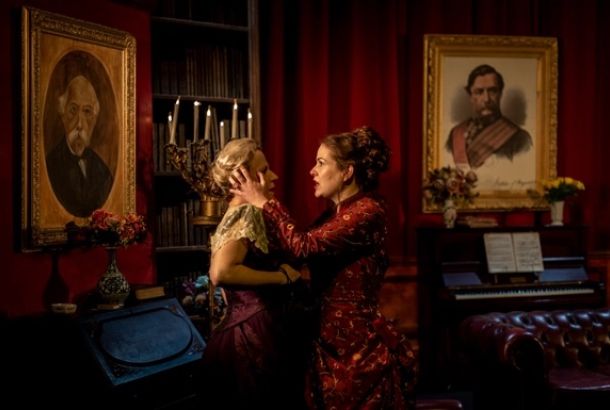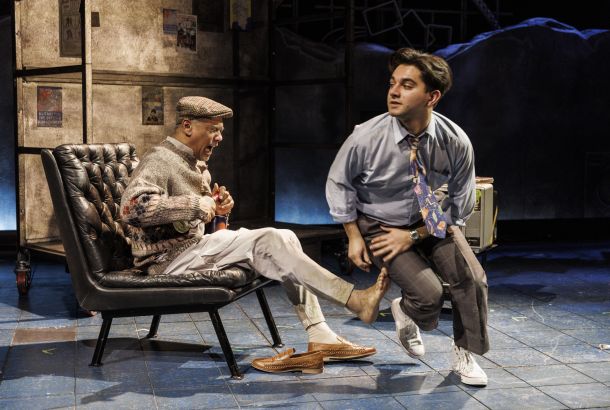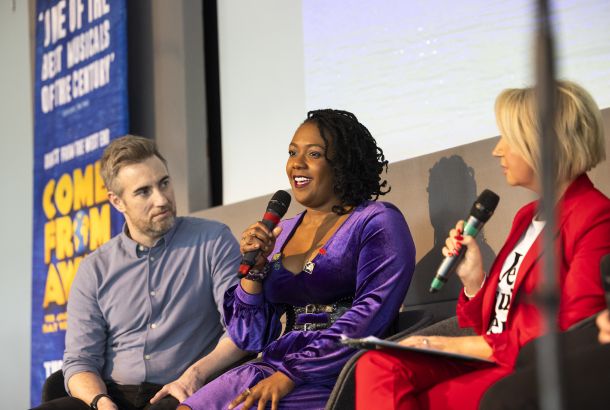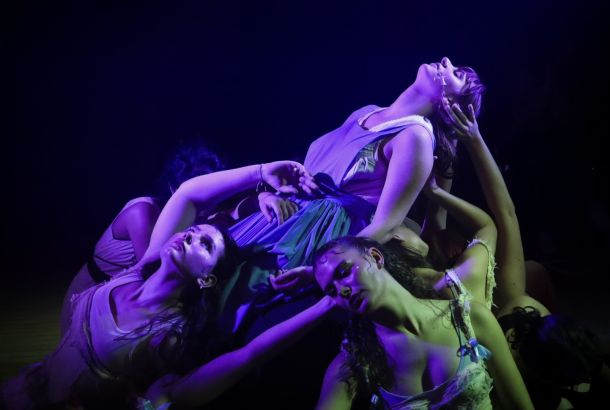
Before I begin this review, let’s have a little history lesson on ballroom and voguing.
The ballroom scene is an African-American and Latino underground LGBTQ+ subculture. Beginning in the late 20th century, Black and Latino drag queens organised their own pageants in opposition to racism experienced in established drag queen pageant circuits. Though racially integrated for the participants, the judges of these circuits were mostly White.
While the initial establishment of Ballroom mimicked these drag queen pageants, the inclusion of gay men and trans women would transform the Ballroom scene into what it is today: a multitude of categories that all LGBTQIA+ people can participate in.
Attendees ‘walk’ these categories for trophies and cash prizes. Most participants in Ballroom belong to groups known as ‘houses’ where chosen families of friends form relationships and communities separate from their families of origin, from which they may be estranged.
Ballroom culture gave marginalised people the opportunity to imagine themselves as the supermodels they saw in Vogue Magazine (hence “voguing”) and even Royalty and deities, whilst incorporating their ethnic culture and gender and sexual identities.
Popularised by Madonna and mainstreamed into the gay community, we must never forget that voguing was invented by working-class queer people of colour. It’s not just a ‘gay dance’ – it’s a culture.
The Black Price MCR Extravaganza
In the UK, many houses are made up primarily of white performers. Liverpool, in particular, has a thriving vogue scene. Yet Liverpool is, well, very white.
The Black Pride MCR Extravaganza (formerly known as The Black Pride Vogue Ball) is the creation of mixed-race Mancunian Darren Pritchard, a director, producer and choreographer. This event is Darren’s effort to reclaim ball culture for the very people who created it.
Now in its third year, I attended the sophomore event to get some footage for the taster tape for my BBC documentary, Bend It Like Bollywood, which explores the queer South Asian experience. This year, I returned as a reviewer.
Whilst other balls require performers to belong to a house, this event is more inclusive in that regard, allowing those without houses (whether by choice or because they have not yet found one) to compete.
Like all balls, there is a host. Like House of Suarez’ long-running Vogue Ball, Black Pride is hosted by Rikki Beadle-Blair MBE (now a Doctor, thanks to a well-deserved honorary degree), who we interviewed a few years back.
Rikki always stresses the importance of acknowledging the origins of ball culture. He reminds us that we are descended from Black Africans, and he asks the audience to let their inner gay Black boy come out. He does this at every single ball because people must never forget the Black origins of not only ball culture but humanity. “By the end of the night,” Rikki declared, “I want you to be so Black that the police stop and search you five times!”
Like all balls, there is a series of categories, each judged by a glamorous panel.
Category 1: Best Dressed
After a fierce opening number and Rikki’s introduction, the competition began. The first category was ‘Best Dressed’. The biggest category of the night, there were scores of performers, each with a distinct and unique costume. The first competitor was dressed in all-pink, like they had just come from seeing Barbie. They wore an oversized square hat that had beads dangling from the sides. It was very old school Lady Gaga (or Shania Twain this past year but let’s not get into that).
There was a South Asian performer in gender-bending South Asian clothing. Val the Brown Queen (formerly known as Val Qaeda) also donned regal South Asian clothing, celebrating her ethnic identity. Val was one of the stars of my BBC documentary.
Another performer walked down the catwalk whilst holding up a piece of gold metallic material. They let the material drop, revealing that it was actually part of their dress. Their outfit was completed by two huge gold globes covering their breasts.
My favourite costume came from Miss Jalebi Bebe, another star of Bend It Like Bollywood, who made her professional debut at the previous Black Pride. She was dressed like a European Queen, complete with a white fur shawl. It was cathartic seeing the descendant of a colonised community imagining herself as European royalty. Best of all, Jalebi had designed the entire outfit herself!
The category was won by Lucky Roy Singh and Huss, “mother” and “chachu” (uncle) of the South Asian House of Spice, which Singh established last year, ahead of the 2022 ball. They were dressed like South Asian nobility, with Lucky carrying a Kirpan (a curved, single-edged blade that Khalsa Sikhs are required to wear as part of their religious uniform) and Huss holding an open book that read “F**K COLONIALISM”.
After all of the performers did their solo walks, they all walked together, before lining up at the back of the stage – the latter of which had not been possible at the previous venue, Gorilla, because that stage is tiny. It was a nice way to compare all of the looks.
The judges took awhile to decide on a winner. “Do we have a winner? What is this, the US election? We need a winner!” Rikki exclaimed.
The category ended in an eight-person battle, with House of Spice prevailing. What they offered was not just a look; it wasn’t even just a concept; it was a story – and that’s why they won.
Category 2: Debutante
The next category, ‘Debutante’, spotlighted newer performers. Yvy DeLuca, aka The BollyWitch, is an established performer but this was her first walk. Whilst most performers vogue, she performed a traditional Indian dance. It was the event’s most beautiful dance, and she made the dance-off.
This category was also won by House of Spice, who were represented by the exhilarating Nick Spice, who incorporated various dance forms in his number.
Category 3: Solo
This was followed by ‘Solo’, essentially the same thing but for more established dancers, such as Mr. Blaque from the House of Blaque. I was at the bar with a friend when Rikki announced Mr. Blaque.
“Xavier’s one of my favourite voguers,” I said as we abandoned our drinks at the bar to catch his performance. Similarly, at last year’s event, I was anxious when my boss asked to speak to me in private, just before Xavier was due to take the stage. One simply cannot miss Xavier!
Xavier is one of the most breathtaking voguers you will ever see. A Greek God with chiseled facial features, he could stand still and be appreciated like a work of art – but when he starts moving, you will be in awe. Dressed in all-black, he wore a leotard, a miniskirt and thigh-high boots; it was all on display, and, boy, did he slay!
The category also featured an appearance from Jaded, another of my favourite voguers, who somehow gets better every time I see him perform. Jaded wore one of the night’s best outfits: a white shoulder shrug shirt, a bra, a miniskirt, garters, and high heels. His look was complimented by his signature brunette afro, which bounced fiercely as he danced.
Jaded’s routine included a chair, which was covered in a sparkling cloth. Midway through his act, he ripped the cloth from the chair and danced on it, before lowering himself to his knees and making love to the floor.
I believe there were two knock-out rounds. Mr. Blaque, Jaded and Fortune competed in a brilliant brown boy three-way. The overall winner was androgynous beauty De’Vill Blaque (Denon James). I have seen them perform a few times; they are mesmerising.
Category 4: KPOC
The penultimate category was ‘KPOC’ (aka Kinky People of Colour), formerly known as ‘Sex Siren’.
After all the acts had taken to the stage, Darren explained that we must recognise the importance of kink amongst queer people of colour. He also called for more kink at Pride: “If you don’t like it, keep your kids at home.”
Judas Darkholm, a former Gender, Sexuality and Culture MA course mate of mine, slayed in this act, with an outfit that included a whip and a tail! Mr. Blaque slayed once again, as a female performer’s “bitch”, complete with a leash and a dog mask, which he lifted to reveal a ball gag. Kaan Huzarski, who I first saw perform at last year’s ball, wore devil horns and a jockstrap. This sex-tastic act had me wondering if the “K” in “KPOC” stood for “kinky” or “Kaan”.
After all of the acts had taken to the stage, Darren revealed, “We’ve got a top,” to which Rikki sassily responded, “We’ve got a top? In this crowd?”
The winner was Auntie Miss Ken Noir, who delivered a sex-positive, body-positive performance that had the audience electric.
Category 5: Lip Sync
The final category was the big one – everybody’s favourite – Lip Sync! As always, Rikki treated us to his own lip sync. This time, he honoured the late, great African-American artist, Tina Turner, with a lip sync to ‘Proud Mary’.
The category was opened by House of Blaque, who were represented by Tyrone Blaque, with Mr. Blaque and De’Vill Blaque appearing later on as their backing dancers. Dressed in an orange dress which covered their head, Tyrone lip synced to Alison Hinds‘ ‘Togetherness’, which had the entire audience bopping.
Ibtisam Ahmed from House of Spice delivered a beautiful mime to Loreen’s ‘Tattoo’, which won Eurovision this year, making her the second artist and first woman to win Eurovision twice. In a blue dress and peacock headpiece, Ibtisam did that majestic song justice.
Chilli Spice (Kesh) from House of Spice brought the disco fever with Lipss Inc.’s ‘Funky Town’, at first dressed like a lollipop man, later discarding his costume to reveal a black vest with a silver chain harness, a sparkly black skirt, and sunglasses.
Val’s lip syncs always include some spoken word. This act included the words of a racist British woman: “I was expecting it to smell like P***s”. Val’s acts often subvert racism and Islamophobia. Her previous stage name, Val Qaeda, was ostensibly a feminisation of Al-Qaeda but also a subversive attempt to play around with Islamophobic stereotypes.
Jalebi then offered us a lip sync to perhaps the most iconic female collaboration of all time: ‘Beautiful Liar’ by Beyoncé and Shakira. Jalebi has belly-danced to an instrumental of the song on social media but this was her first time performing to the track. She wore a pink belly dancing outfit and even a pink wig – again, like a Barbie mega-fan!
Whilst Lucky Roy Singh usually wears Indian clothing for her performances, she wore denim for her lip sync, complete with a denim jacket with her name printed on it which she wrapped around her waist. Towards the end of her performance, she picked up an umbrella and opened it, with petals showering her. She lip synced to ‘Bol Bol Bol’ by Tigerstyle and Miss Rimpi.
Lucky is known for incorporating Giddha (a popular Punjabi folk dance) into her performances. Giddha details stories of women’s lives, including sexuality. Lucky feels passionately about the difficulties faced by South Asian women; at least year’s event, one of her performances was dedicated to the victims of honour killings.
Sadly, most of the performances were cut short because, whilst the event organisers thought they had the space until 12:30am, they actually only had it until 11pm! Fortunately, all of the acts (including the remaining acts) got to deliver their performances in full in the downstairs bar.
The category was won by the beautiful Meme Gold, who had a memorable fake hairy boob reveal, reflecting their mission to make hairy bodies normal (follow @imsohairyitscute). They competed in a lip sync battle with Tyrone Blaque, in which they performed Mariah Carey’s ‘Fantasy’, with Meme ultimately taking home the trophy (well, a limited edition fashion doll).
The Black Pride MCR Extravaganza is a beautiful tribute to the mothers and fathers of ball culture, which showcases and celebrates contemporary queer people of colour. Whilst white houses might be fine somewhere as white as Liverpool, that’s not going to fly in a city as cosmopolitan as Manchester. Ball culture was invented by African-Americans and Latinos in New York but this British (and specifically, Mancunian) event also celebrates other people of colour, especially South Asians and East Asians. It’s a safe space for British people of colour to shine.







